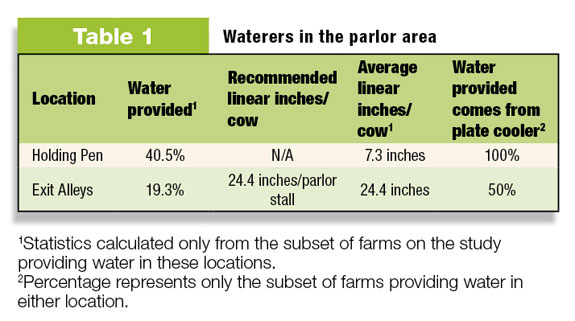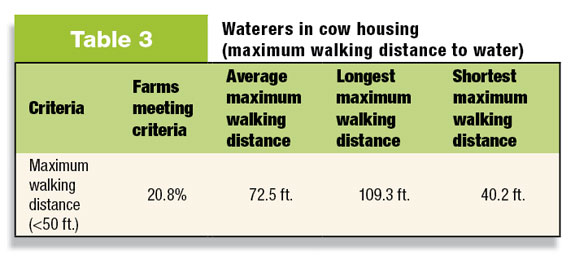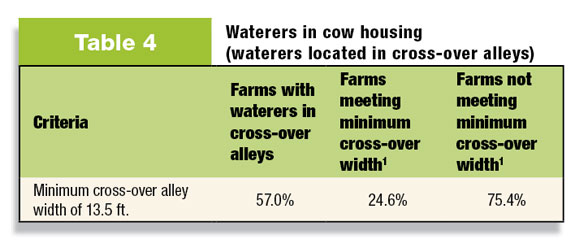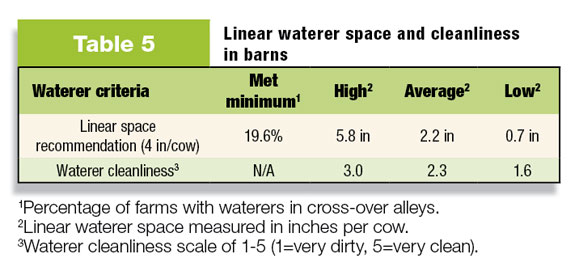In the previous two parts of this series, the extreme importance of drinking water for dairy cattle was emphasized. Click here to read the first part of this series and here to read the second part of this series.
By weight, water is the most important nutrient for milking cows. The previous articles focused on the chemical and mineral composition of dairy cattle drinking water and the steps to take if your cows’ drinking water contains high levels of undesirable constituents.
It is recommended you test your farm’s water for the constituents most often leading to water quality issues – total dissolved solids (TDS), sulfate (SO4), chloride, (Cl), iron (Fe) and nitrate-nitrogen (NO3-N) – and take action if any of these constituents are consistently above actionable levels.
A cow’s water intake can be influenced by many factors, including dry matter intake (DMI), milk production, sodium (Na) intake and air temperature. This leads to wide variations in water requirements among milking cows.
For example, at 60ºF a cow milking 40 lbs per day will eat an estimated 42 lbs per day of dry matter (DM) and drink about 10.1 gallons per day less water than her herdmate producing 100 lbs milk per day and eating 60 lbs per day of DM.
Both cows will increase their water consumption by about 3.5 gallons per day when the temperature increases from 60ºF to 80ºF. These intake figures assume water quality is satisfactory and no other factors are interfering with water consumption.
Even though water quality may be fine, other issues may prevent cows from satisfying their water needs. Thus, analyzing cows’ drinking water is only the first step to ensure that “water nutrition” and water intake are satisfactory.
Remember, drinking water should receive attention in two regards: water quality (“Is your water fit to drink based on its chemical and mineral composition?”) and water delivery (“Are you providing an ample supply of good-quality, fresh, clean water to your cattle?”).
Water quality is addressed by the chemical/mineral analysis. Water delivery concerns such issues as numbers of waterers per group and waterer location, size and cleanliness. The most common waterer problems on dairy farms are inadequate number of waterers, inadequate watering space, poorly designed watering spaces and dirty waterers.
Parlor area
Provide about 2 linear feet of watering space per milking parlor stall in return alleys from the milking parlor (e.g., 40 feet of watering space for a double-20 parlor). Warm plate cooler water is a good source since cows prefer to drink warm water.
This is true even in warm weather and warm climates. Remember, milk is about 87 percent water and cows may drink as much as 50 to 60 percent of their total daily water intake immediately after milking, if given the opportunity.
Waterers in cow housing areas
Provide a minimum of two waterers per group and cows should not have to walk more than 50 feet to get a drink of water. Waterers should be located close to feedbunks and protected from direct sunlight. Direct sunlight promotes algae growth, which decreases water palatability.
It is crucial to provide adequate open space around waterers. This is particularly important for waterers located in cross-over alleys. Cross-over alleys should be at least 13.5 feet wide to allow adequate watering and walking space. There should be approximately 4 inches of linear waterer space per cow in every group.
It is critical to provide adequate waterer space and locate waterers properly to keep boss cows from preventing other cows from obtaining adequate water.
Waterer cleanliness
Waterer cleanliness is the final, but very important, critical link in water nutrition. How clean? Would you be willing to drink from it? If the answer is “no,” then clean it. Water trough cleaning should be a regular chore that receives high priority.
Thumb H2O Project
The Thumb H2O Project involved 36 dairy farms in Huron, Sanilac, St. Clair and Tuscola counties of Michigan. Milking cow drinking water was sampled on each farm and then analyzed using the services of a certified commercial laboratory. These results were presented in the first article of this series.

In addition, data were collected from milking parlors and milking cow housing facilities on these farms concerning waterer numbers, space, location and cleanliness. Results of this aspect of the Thumb H2O Project are presented in Tables 1 through 5 below.
Parlor area
Table 1 presents the data concerning waterers in the parlor area. Only 40.5 percent of the farms provided drinking water in the parlor holding pen and only 19.3 percent provided drinking water in the parlor exit alleys.
All the farms supplying drinking water in the parlor holding pen used recycled plate cooler water, while only 50 percent of the farms providing drinking water in the parlor exit alleys used recycled plate cooler water. The water offered in parlor holding pens was usually offered using an oval drinking tub.
In each case of water offered in the parlor exit alleys, water trough linear space met, or exceeded, minimum recommendations. These data indicate that opportunities exist on many farms for increasing drinking water availability to milking cows. It should be noted, however, that waterers in these areas were, on average, quite dirty.
The average cleanliness rating was only about 1.5 (1=very dirty, 5=very clean). One would naturally expect these waterers to be dirtier, since all milking cows have access to them at least twice per day and cows drink more water immediately after milking.

These drinking water sources probably should be cleaned at least daily and, preferably, after or before every milking. Also, some of these waterers were nearly empty. Granted, most farms were evaluated during times cows were not being milked.
But be sure waterers in these areas remain nearly full when cows are present. This may require supplemental sources of water if plate cooler water is unable to fully meet the demand.
Cow housing areas
Table 2 indicates that every farm in the study met the minimum recommendation of two waterers per group.
In some respects I question the full importance of this criterion, since total linear waterer space may be the more important indicator of whether or not cows are exposed to adequate amounts of drinking water.

Table 3 shows that only about one in five farms met the recommendation (50 feet or less) for maximum walking distance to water.
The average maximum walking distance was over the limit by 22.5 feet (72.5 feet), the longest distance was over double the recommended maximum (109.3 feet), and the shortest was about 10 feet below the maximum (40.5 feet).
As I collected these data, it became obvious that the larger and newer freestall barns were clearly those barns that most often exceeded the recommended maximum walking distance to water. However, these barns also tended to have the greatest linear feet of waterer space.
Perhaps exceeding the walking distance maximum is less critical as long as adequate linear space is provided.

Table 4 presents waterer data in cross-over alleys. Only slightly over half (57 percent) of the farms had waterers in cross-over alleys. Most of these farms tended to have older freestall barns.
Less than 25 percent of farms with cross-over alleys met the recommended minimum width of 13.5 feet. The barns meeting this recommendation also tended to be newer freestall barns. Many older barns have cross-over alleys only 8 to 10 feet in width.
Waterers in these narrow cross-over alleys are difficult for large cows to access and easy for boss cows to defend, keeping more submissive cows from drinking. It should be remembered that when these older barns were built they met the standards existing at the time.

Table 5 presents the data on waterer linear space and cleanliness. There were wide variations in waterer linear space per group. The average linear space was 2.2 inches per cow, about half of the recommendation (4 inches per cow).
The highest linear space was well above the recommendation at 5.8 inches per cow and the low was a meager 0.7 inch per cow. Once again, the farms with lower linear waterer space tended to have older freestall barns, while those providing adequate space tended to be newer facilities.
Some of the older barns were equipped with dual waterers providing only 2-inch to 10-inch watering spaces per waterer. This appears to be very deficient, especially when these waterers are often located in narrow cross-over alleys.
In my opinion, nearly every farm evaluated could do a better job to keep waterers clean. Admittedly, waterer cleanliness is a subjective measure. I used a scale of 1 to 5 with 1 being “very dirty,” and 5 being “very clean.” On average, most water troughs were very dirty.
The best farm scored an average cleanliness rating of 3.6 and the worst farm scored only 1.6. Most producers indicated they routinely clean water troughs every one to two weeks.
Clearly, water troughs should be cleaned at least weekly and possibly twice weekly. It should be a high-priority routine chore.
Conclusion
These data clearly indicate that only a few farms (about 30 percent) provide water in the parlor area. I recommend that every dairy farm should give serious consideration to offering water in one or both parlor locations (holding pen, exit alleys).
This is especially true if the housing area is below the recommended waterer linear space, exceeds the maximum walking distance recommendation and/or has numerous waterers located in narrow cross-over alleys.
Correction of waterer deficiencies in housing areas is problematic. Many farms’ waterer linear spaces were less than half the recommendation. In those instances, additional waterer space in the barn should be a high priority.
Many of those barns could be easily retrofitted with larger waterers. Those farms with adequate waterer space and longer walking distances would require more extensive remodeling to decrease walking distance to water.
I question any benefit of more waterers as long as waterer linear space meets or exceeds the recommendation. However, those farms exceeding the minimum walking distance or with numerous waterers in cross-over alleys may be good candidates for offering water in the parlor area.
In new construction or major renovations, the number of waterers, maximum walking distance to water, waterer linear space, water trough design and location should receive more attention.
All farms, regardless of age of facilities or other water-related considerations, would benefit from increasing the frequency and intensity of waterer cleaning.
Is the water nutrition program on your farm adequate? Does it meet current recommendations? Do you routinely test your water for composition?
Do you know how many waterers are available and whether they are working properly? Do you know the maximum distance cows have to walk in your barn to get water? How much waterer linear space is in your barns?
And, are cows’ waterers clean? Maybe you don’t know the answers to these questions, but your cows do; they are responding through their performance or lack thereof. PD
References omitted due to space but are available upon request to editor@progressivedairy.com.
—Excerpts from Michigan Dairy Review Vol. 16, No. 3, pgs 9-11 & 22
Craig Thomas is an extension dairy educator withMichigan State University Extension. Email Craig Thomas.








